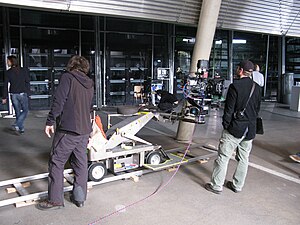Camera dolly: Difference between revisions
Mike Rosoft (talk | contribs) m Reverted edits by 93.97.187.12 (talk) to last revision by Schlaier (HG) |
|||
| Line 10: | Line 10: | ||
Dolly moves may also be executed without track, giving more freedom on the horizontal plane and with it, a higher degree of difficulty. These are called dancefloor moves and may either be done on the existing surface (if smooth enough) or on an overlay designed for dolly movement. The ground overlay usually consists of thick [[plywood]] as a bottom layer and [[masonite]] on top. |
Dolly moves may also be executed without track, giving more freedom on the horizontal plane and with it, a higher degree of difficulty. These are called dancefloor moves and may either be done on the existing surface (if smooth enough) or on an overlay designed for dolly movement. The ground overlay usually consists of thick [[plywood]] as a bottom layer and [[masonite]] on top. |
||
Camera dollies have several steering mechanisms available to the dolly grip. The typical mode is rear-wheel |
Camera dollies have several steering mechanisms available to the dolly grip. The typical mode is rear-wheel queering, where the front wheels remain fixed, while the wheels closest to the operating handle are used to turn. A second mode, round steering, causes the front wheels to turn in the opposite direction from the rear wheels. This mode allows the dolly to move in smooth circles and is frequently used when the dolly is on curved track. A third mode, called crab steering, where the front wheels turn in the same direction as the rear wheels. This allows the dolly to move in a direction diagonal to the front end of the dolly. |
||
==Types== |
==Types== |
||
Revision as of 18:22, 14 March 2011


A camera dolly is a specialized piece of film equipment designed to create smooth camera movements. The camera is mounted to the dolly and the camera operator and camera assistant usually ride on it to operate the camera. The person who operates the dolly is known as a dolly grip. They are a dedicated technician trained in its use.
Movement
The camera dolly may be used as a shooting platform on any surface but is often raised onto a track, to create smooth movement on a horizontal axis. Additionally, most professional studio dollies have a hydraulic arm that raises or lowers the camera on the vertical axis. When a dolly grip operates a dolly on perpendicular axes simultaneously, it's known as a compound move.
Dolly moves may also be executed without track, giving more freedom on the horizontal plane and with it, a higher degree of difficulty. These are called dancefloor moves and may either be done on the existing surface (if smooth enough) or on an overlay designed for dolly movement. The ground overlay usually consists of thick plywood as a bottom layer and masonite on top.
Camera dollies have several steering mechanisms available to the dolly grip. The typical mode is rear-wheel queering, where the front wheels remain fixed, while the wheels closest to the operating handle are used to turn. A second mode, round steering, causes the front wheels to turn in the opposite direction from the rear wheels. This mode allows the dolly to move in smooth circles and is frequently used when the dolly is on curved track. A third mode, called crab steering, where the front wheels turn in the same direction as the rear wheels. This allows the dolly to move in a direction diagonal to the front end of the dolly.
Types
Studio dollies are large, stable and can feature hydraulics. These are the first choice for studio, backlot and location shoots when using professional cameras. A studio dolly usually needs a specialized operator called a "dolly grip". Lightweight dolly systems are simpler, more affordable and are best used with lighter-weight cameras. Lightweight systems are usually favored by independent filmmakers and students because they are easier to operate. There are riding dollys and also dollys that support only the camera, so that the operator needs to walk alongside. Any dolly that is compact in size when set on floor wheels is called a "doorway dolly." The best way to be able to replicate the same camera movement for multiple takes (which is important for editing) is to use a dolly on track.
Track
Dolly tracks used for heavy cameras have traditionally been constructed of steel or aluminium. Steel, although heavier than aluminum, is less expensive and withstands heavier use. Longer track segments, while heavier to transport, allow track to be laid straighter with less effort. Curved track is also available. Plastic versions of track have been used with lightweight dolly systems. In the 2000s, flexible rubber track allowed quicker set up and easier transportation for use with light cameras.
Gallery
-
Examples of steel dolly track
-
A lightweight riding dolly on flexible track with a seat.
-
A lightweight camera dolly with floor wheels.
-
Creative use of flexible track with a 3-leg spider dolly.



